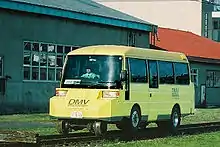Dual-mode transit
Dual mode transit describes transportation systems in which dual-mode vehicles operate on both public roads and on a guideway; thus using two modes of transport.[1]

JR Hokkaido DMV tested.
In a typical dual mode transit system, private vehicles comparable to automobiles would be able to travel under driver control on the street, but then enter a guideway, which may be a specialized form of Railway or monorail, for automated travel for an extended distance.[2]
Dual mode systems under development include the TriTrack, the RUF, Roam Transport's CargoRail and JR Hokkaido DMV.[1] Dual-mode transit seeks to address a similar audience as personal rapid transit but with the capability to "travel the first and last miles off-guideway using onboard energy storage".[2]
See also
References
- Jerry Schneider. "Innovative Transport Technologies: Dualmode Transportation Concepts".
- Christine Ehlig-Economides & Jim Longbottom (2008). "Dual Mode Vehicle and Infrastructure Alternative Analysis" (PDF). Texas A&M University.
External links
- Jerry Schneider's Dual Mode page
- Center for Energy, Environment, and Transportation Innovation
- JR Hokkaido DMV
- "The Secret Behind the DMV's Road to Rail Transformation". Scope. April 2008.
This article is issued from Wikipedia. The text is licensed under Creative Commons - Attribution - Sharealike. Additional terms may apply for the media files.
